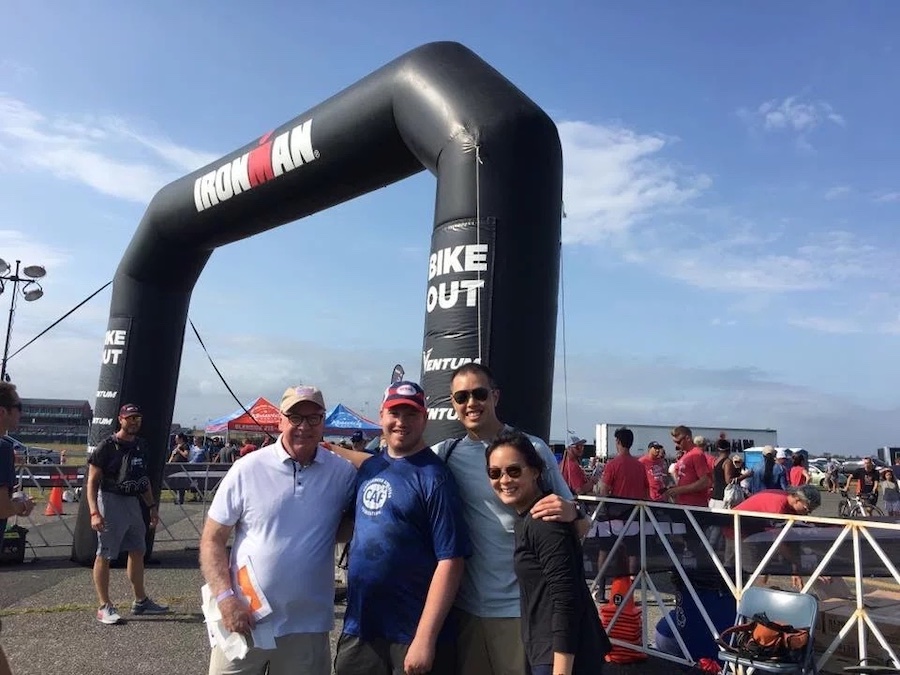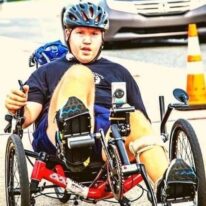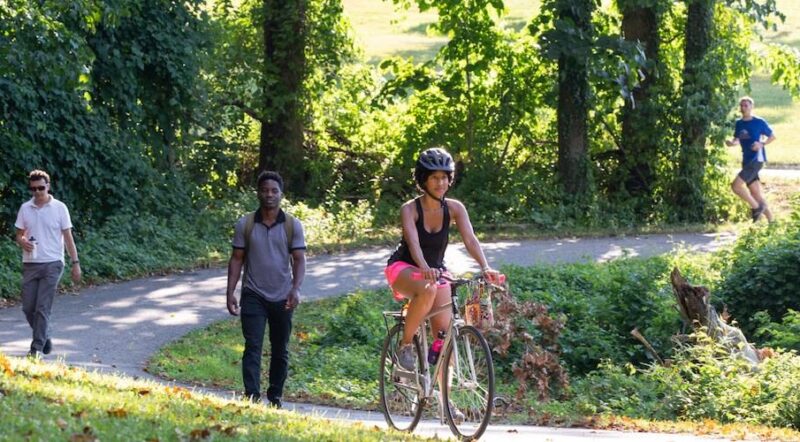Finding Freedom on Your Bike as an Adaptive Cyclist

Special thanks to the Bicycle Coalition of Greater Philadelphia for permission to repost content from this blog series authored by adaptive cyclist and competitive athlete, Patrick Sweeney, who lives with a disability that affects his movement, balance and vision.
“If you need something [on the trail], you can’t be afraid to advocate for yourself.”
—Patrick Sweeney
My name is Patrick, and I am an adaptive cyclist. That means I cycle, but I do it on a type of bike that works with my disability. I have left-sided hemiparesis. That means my movement, balance and vision are impaired on my left side.
But, my hemiparesis doesn’t stop me from cycling. Adaptive cycling is a great sport for people with disabilities, because it brings a sense of freedom.
Because of my disability, I can’t drive, and I have to walk carefully. But, adaptive cycling gives me the ability to go wherever I can go on a bike. I get to ride on back roads and trails, and I see towns I’ve never been to before. It lets me access the outdoors, which I love. I get to explore lots of gorgeous scenery like woods, lakes and fields. In a competition, I don’t know where the end will be or what I’ll see next. It’s exciting!
But the freedom of cycling goes beyond the physical freedom. It gives you a mental freedom. For me, it is freedom to belong to my cyclist club, and to be able to participate in a sport. In regular life, people sometimes don’t know how to interact with a person who has a disability (even though we’re just like everyone else)!
But at cycling competitions, I stand out on my adaptive trike, and people want to talk to me about it. People say they are amazed that I can ride so far on my trike, and that I inspire them to keep going. There is so much camaraderie on rides. During competitions, we encourage each other: “You can do it, no matter what!”
Related: Trail Moments | Connecting to Nature, Connecting as a Family, on America’s Trails
Work Up to It

You can do it, as long as you practice. That’s the other part of the mental freedom of cycling. Once you get into it, you realize the possibilities of what you can do.
For example, my first competition was a 15-mile bike “sprint.”
I worked up to longer distances and built it up. With a few years of practice, I was able to do a 57-mile, hilly ride for Ride for Ataxia. That was the hardest thing I’ve done in my life! But now when I face a challenge, I think, “If I could do 57 miles on hills, I can do this too.”
Cycling gives me confidence, and it gives me the freedom to forget my “limitations.”
If you are interested in experiencing this freedom too, I’ll be writing a series of posts about Adaptive Cycling here. I’ll give practical tips and information about the sport, like where to ride and where to get the right equipment.
Anything is possible when you know what you can achieve in even a small amount of time!
Related: Trail Moments | Enjoying the Trike Life
Safety Tips for Adaptive Rides and Equipment

When you’re going out to ride on an adaptive bicycle, it’s important to think about safety. You want to be aware of your surroundings. Part of [that] is being prepared. Before I ever started long trail rides, I practiced in my neighborhood. Bikes have to follow the same traffic rules as cars. If you have a disability and have never driven before, you’ll need someone to teach you the rules. I had an awesome rehab therapist who rode her bike with me. She taught me in a safe area I was familiar with.
Before you go on a ride, do your research. Know your route ahead of time. Adaptive trikes are very wide. Make sure a trail has enough space, or that a road has a wide enough shoulder.
You have to know the capabilities of your equipment for the terrain. Read the trail map, and look for areas where you could stop or take shelter. There usually aren’t tunnels or shelters, so check the weather! When you first visit a trail, know who’s around to help.
For example, you can give park rangers a heads up you’ll be out there. Sometimes they’ll ride with you. We first got in touch with our park rangers by contacting our local trail association. The trail associations can tell you about conditions of the trail and provide safety resources.

For more information on your local trail—including websites, contact info and more—check out TrailLink.com™, which catalogues details on more than 40,000 miles of multiuse trails cross the country.
Another trick for finding help on the trail is to look for the mile marker signs. Sometimes, they have an emergency number you can call. If they don’t, you can just call 911, and say, “I need a park ranger.”
Obviously, it’s important to always bring a fully charged cell phone, to be able to call for help if you need it. Sometimes, you may need help, but it’s not an emergency. Like one time, my shoe fell out of my brace, and my riding partner had to help me put it back in.
If you need something, you can’t be afraid to advocate for yourself. Wave someone down. Explain your current situation, like, “My foot fell out of my pedals, but I can’t get it back in myself.”
How do people respond? It depends on the day, to be honest. Some people are really nice, and we have a good conversation. On a busy day, some people may not stop, and you should be prepared for bypassers to not always help. That’s why, when you’re riding with a disability, it’s better to never ride alone. Go with a friend, or a group. Your team can help you if you get a flat tire or if you fall. They may also be able to see things ahead that you can’t.
Adaptive cycles are low to the ground, so the visibility is different. It can be harder to see cars and around blind turns. So you need to go slow around turns, and make sure to stop before crossing the street. You need to use all your senses. If you hear a car coming, wait. Don’t try to ride when visibility is bad. The best time for me to ride is 7:30 a.m.
It’s less crowded, and you have no worries about it getting dark soon. Be vocal on the trail to make people aware of where you are. Call out if you will be passing them. Because you are low to the ground, you have to make yourself visible to others too. Use anything that can make you more visible, like a neon vest and helmet. The most important safety tips for cycling are, have a flag on your bike and have reflectors on your bike.
Do your research, advocate for yourself, and have visibility! That will help keep you safe.
Related: How to Get Back on a Bike—Years Later (8 Simple Tips)

Donate
Everyone deserves access to safe ways to walk, bike, and be active outdoors.



